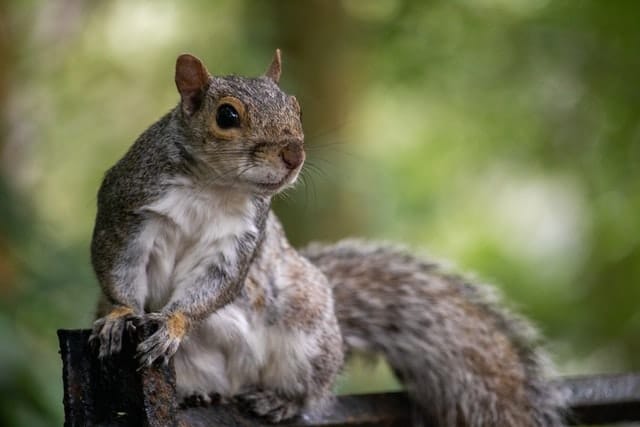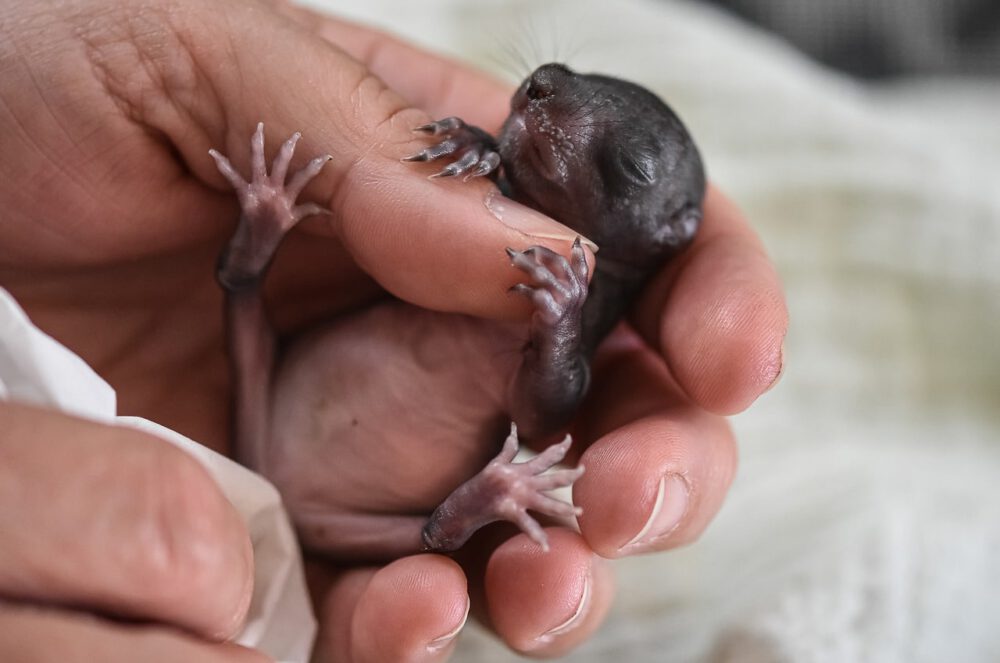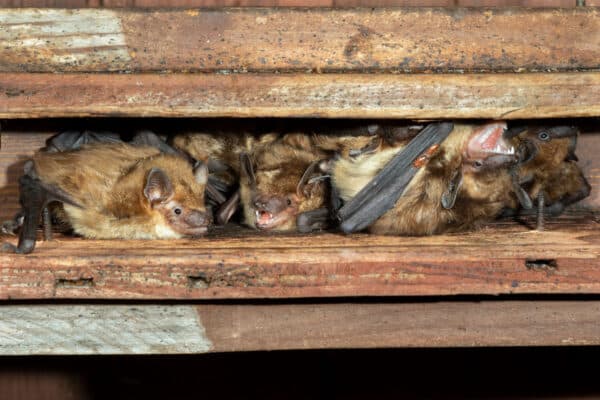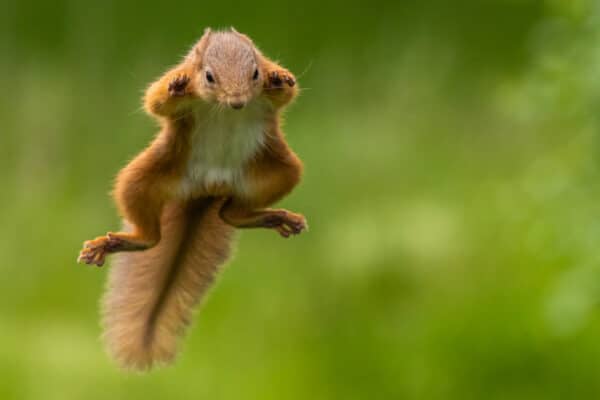
Have you found a cute and tiny baby squirrel in the attic or yard? Is your home or yard the ideal place for the squirrels to make a nest and thrive? If so, you may want to learn about the squirrel and then the reproductive habits. Then you can get to when grey squirrels have babies. But, if you have an infestation and the squirrels are nesting, contact Covenant Wildlife Removal to safely and humanely remove and relocate the gray squirrels as well as the babies.
Facts About the Grey Squirrel
The grey squirrel is a tree squirrel, able to leap and bound great lengths to reach the nesting place or food source it is after. And the grey squirrel is a large and impressive species that is most integral in the restoration and renewal of the natural forests in North America. Now, that is impressive, but if they are in your home, trying to renew your attic into a nesting place, you may not be so thrilled.
Appearance
Appropriately named, the grey squirrel is just that. It is a squirrel with a majority grey and some brown fur, with a bright white underbelly. Getting to know the grey squirrel, you will identify the following attributes.
- Length: Head and body length can grow up to 11.8 inches.
- Tail length: Just shorter than the head and body length.
- Weight: between 14 and 21 ounces.
These bounding animals have four toes on the front feet and five on the back, making their tracks easily identifiable. Grey squirrels have incisor teeth that will continue growing at a rate of 6 inches per year for life. And that is where homeowners start to have a concern.

Behavior
These acrobatic squirrels can run, jump, and climb just about any surface, which is not good news for homeowners.
Below is a list of the various squirrel habits homeowners should be aware of.
- Squirrels will gnaw their way into the tiniest opening in your home or roofline.
- They will climb a brick wall up to around four stories.
- Their strong teeth and jaws can chew right through aluminum.
- Squirrels are territorial and will fight for their space.
- The females can have two liters of one to four pups each year.
- Interestingly, they work together to accomplish their goals and warn one another of danger.
- Chatty and loud in the attic, they will keep you up at night.
- Grey squirrels will defecate and urinate in one spot creating a pile and a mess for you.
Diet
Grey squirrels eat a range of foods, including tree bark, blowers, berries, seeds, acorns, nuts, and fungi. They may even raid your garden. Occasionally, they will feast on insects, frogs, birds, eggs, small rodents, and even other squirrels.
Should you have a grey squirrel making piles of nuts in your attic, please call the wildlife removal services of your Covenant Team.
Reproduction Age and Habits of the Grey Squirrel
Baby squirrels reach adulthood around nine months of age. Then they need a bit more time to reach sexual maturity. Female grey squirrels typically reach sexual maturity when they are 15 months old. At the same time, the male squirrels are sexually mature closer to 12 months old. The mating season is usually between the months of January to February and then again from June to July.
Now, grey squirrels do not mate for life and are actually very sexually active. A male will mate with many partners, as will the female. And this mating process is quite a show. The male will chase the female and scare away other males until she decides he is the one… for now anyhow.

Baby Grey Squirrel Season
When spring is here, so are the baby squirrels. Then again, you may see babies in the fall for the second liter of the year. The gestation period is usually 45 days. And each liter is typically two to eight babies.
When born, they weigh about one ounce and are only one inch in length. In addition, they’re entirely hairless, deaf, and blind, leaving them defenseless. But mama squirrels are excellent caretakers for their young. She will go to great lengths to protect her young. This is why it is best to call a professional out to deal with her and the babies safely.
Leaving the Nest
The little ones will be ready to leave the nest just after seven to ten weeks. Once they wean, they will begin to venture out. However, they stay close to Mama until they learn the skills they need for survival.
According to the squirrel experts at Squirrels At The Feeder, this is the timeline for their development.
- 1-2 weeks old: Pink skin, eyes, and ears closed. Kits are nursing.
- 2-3 weeks old: Dark skin, eyes, and ears closed. Kits are nursing.
- 3-4 weeks old: Fuzz-type fur, eyes, and ears closed. Kits are nursing.
- 4-5 weeks old: Fur development, eyes and ears open. Kits are nursing.
- 6-7 weeks old: Bushy tail and looks like a miniature adult. Kits are nursing.
- 7 weeks old: Weaning begins, and solid food is introduced.
- 10 weeks old: Weaning is complete.
- 11 weeks old: Young squirrels leave the nest and are independent.
One another fact to note is the behavior of Mama before she gives birth. You see, Mama grey squirrel can become more aggressive with the hormonal surge. But once they are born, she will return to her good nature. In fact, many people enjoy watching the baby squirrels run around and play with Mama. Just as long as they are not in your home, it can be pretty entertaining.
If you do have a mama squirrel who has nested in your home or attic, leave the removal to Covenant Wildlife Removal.
Covenant Wildlife Removal Removes Grey Squirrels
Covenant Wildlife Removal comes in to save the daytime from the chatter and scurrying noises in your attic or ceiling, whether there are adult squirrels or babies. The most common way to remove squirrels is to trap them. Poison is not recommended because the animal can die in the home and create additional issues. What’s more, the poison is dangerous around children and pets.
However, you need not worry about that. At Covenant Wildlife Removal, we will find the entry points and seal them up, remove the squirrels, and clean up after them. We are fully equipped and experienced at getting to the source of the problem and eradicating the wildlife.
Squirrel Removal Service includes:
- Trapping, Removal, and Relocation
- Clean Up
- Disinfection
- Odor Removal
Repair of the area Covenant Wildlife Removal is a top-rated local family-owned, full-service wildlife trapping, removal, and repair service. We can remove a squirrel or other rodent infestation before it becomes an extensive problem for you and your family.
Contact us or call 205-850-5760 to set up an inspection.




